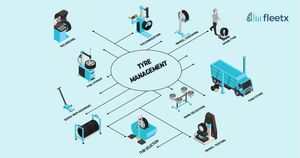
Tyres are the unsung workhorses of every logistics fleet. They carry the load, bear the stress of uneven roads, and directly influence fuel efficiency, vehicle safety, and overall operating costs. Yet, for many fleet operators in India, tyre management remains an afterthought—handled reactively rather than strategically.
Tyre management, in simple terms, is the systematic monitoring, maintenance, and optimization of tyres throughout their lifecycle—from purchase to replacement. It involves tracking key metrics like tread depth, pressure, rotation schedules, retreading cycles, and mileage performance. A well-implemented tyre management system ensures that tyres deliver maximum value before they wear out, while also preventing unexpected breakdowns.
For a typical fleet that operates hundreds of trucks across multiple routes, manual tracking is chaos waiting to happen. That’s where digital tyre management solutions like Fleetx Tyre Management Module step in—bringing AI-powered precision and automation to an area that directly affects both safety and profitability.
Why Is Tyre Management Important for Fleet Operators?
Let’s put it bluntly—tyres can make or break a fleet’s bottom line. Poorly maintained tyres are responsible for nearly 20% of all truck breakdowns and contribute up to 30% of a vehicle’s total operating costs. That’s not just a maintenance problem; it’s a business risk.
Efficient tyre management does more than just extend tyre life—it optimizes vehicle performance, improves fuel economy, and reduces downtime. For truck/bus radial tyres (TBR) in India, tyres contribute about 7% of the total cost of operations for a truck-fleet customer, and they stand as the second-highest variable cost head after fuel.
For Indian fleet operators navigating long, diverse routes—often with overloaded trucks and inconsistent road quality—tyre wear is accelerated. Without real-time tracking, it’s easy to miss early warning signs like pressure drops, irregular tread wear, or alignment issues. The result? Blowouts, unplanned stoppages, and expensive roadside repairs.
Moreover, the absence of structured data leads to poor purchasing decisions—fleets either overstock or underutilize tyres, draining working capital. Tyre management software bridges this gap by enabling data-backed decision-making. Operators can analyze tyre usage patterns, predict replacement timelines, and choose vendors based on performance metrics, not gut instinct.
In short, tyre management isn’t just a maintenance task—it’s a profit lever that affects safety, uptime, and operational efficiency at scale.
Developing an Efficient Tyre Management Strategy
Building a solid tyre management strategy isn’t about checking air pressure once a week—it’s about integrating visibility, accountability, and analytics into daily fleet operations. Here’s how forward-thinking logistics operators are doing it:
1. Standardize Tyre Procurement and Usage
An efficient strategy begins with consistency. Selecting the right tyre brands and specifications based on vehicle type, load profile, and route conditions ensures predictable performance. Standardization simplifies maintenance and helps benchmark tyre life across the fleet.
2. Track Tyre Lifecycle Digitally
Modern fleet management systems allow operators to record each tyre’s unique ID, purchase date, installation position, and rotation history. This digital trail helps detect early performance deviations and forecast replacement timelines, minimizing surprises on the road.
3. Implement Routine Inspections and Predictive Maintenance
Periodic checks for pressure, tread wear, and alignment should be supported by AI alerts that flag anomalies in real time. Predictive algorithms, as used in solutions like Fleetx, can anticipate issues before they escalate into breakdowns.
4. Optimize Tyre Retreading and Disposal
Not all tyres deserve an early retirement. A structured retreading policy maximizes tyre ROI while ensuring safety standards. By tracking retreading history digitally, fleets can make data-driven calls on when to reuse or discard a tyre.
5. Trained Drivers and Technicians
Even the best tyre strategy fails without human discipline. Training drivers to recognize warning signs—like vibrations or uneven wear—and technicians to perform standard checks helps maintain long-term tyre health.
Fleetx – A Leading Choice Among Fleet Owners for Efficient Tyre Management
Fleetx has established itself as a frontrunner in the Indian logistics tech landscape, and its Tyre Management Module is a testament to that innovation. Here’s what sets it apart:
Centralized Tyre Data Dashboard
Fleetx gives managers a single interface to monitor every tyre across the fleet—tracking its performance, age, cost, and rotation history. No more manual logs or spreadsheet chaos.
Tyre Position and History Mapping
Every tyre is digitally tagged and mapped to a vehicle, axle, and position. Managers can instantly view where each tyre is installed and how it has performed over time, enabling smarter inventory control.
Real-Time Alerts and Condition Monitoring
AI-driven tyre analytics flag irregular wear, pressure drops, or performance deviations that impact fuel efficiency—helping fleet managers act fast and avoid costly on-road failures.
Expense Tracking and ROI Analysis
Fleetx’s system automatically captures costs—purchase, repair, retreading, and disposal—helping operators calculate cost per kilometre and identify high-performing tyre brands or vendors.
Seamless Integration with Fleet Operations
Unlike standalone tools, Fleetx’s Tyre Management Module integrates with trip data, fuel consumption, and vehicle health metrics—giving a holistic view of how tyres impact overall fleet performance.
How Do Logistics Businesses Benefit from the Fleetx Tyre Management Module
The benefits of adopting Fleetx’s tyre management solution go beyond maintenance—they cascade into every aspect of fleet efficiency and profitability. Here are the top five advantages that logistics businesses experience:
1. Reduced Downtime and Maintenance Costs
By tracking tyre health in real time, Fleetx enables preventive maintenance. Fleets experience fewer blowouts, lower roadside failures, and up to 20% reduction in maintenance-related downtime.
2. Extended Tyre Life and Optimized Inventory
Automated lifecycle tracking ensures tyres are used to their full potential without compromising safety. Fleets can plan replacements better and avoid over-purchasing or underutilization.
3. Enhanced Fuel Efficiency
Underinflated or unevenly worn tyres increase fuel consumption by as much as 10%. Fleetx’s automated alerts ensure optimal tyre pressure and alignment, directly improving mileage across the fleet.
4. Improved Safety and Compliance
By proactively identifying tyre issues, Fleetx reduces accident risks and helps fleets comply with safety norms. Digital documentation ensures audit readiness for insurance and compliance checks.
5. Data-Driven Decision-Making
Fleetx’s analytics turn tyre data into actionable insights. Fleet managers can identify which tyres offer the best cost-per-kilometre performance, enabling smarter procurement and vendor management.
These aren’t theoretical benefits—they translate into tangible savings and competitive advantage. For logistics businesses operating on thin margins, every rupee saved on tyres and fuel goes straight to the bottom line.
The Road Ahead Rolls on Data
Tyres might look simple—just rings of rubber—but they represent a fleet’s most consistent operating expense and one of its biggest safety concerns. In an era where logistics operations are moving toward AI-driven optimization, ignoring tyre management is like leaving money on the road.
The Fleetx Tyre Management Module transforms this overlooked aspect into a strategic advantage. It empowers fleet operators with visibility, control, and predictive intelligence—helping them achieve better uptime, lower costs, and safer operations.
As the Indian trucking industry modernizes, the winners will be the fleets that combine mechanical reliability with digital intelligence. Fleetx doesn’t just help them manage tyres—it helps them manage outcomes. Because in logistics, every kilometre is crucial.
What exactly does the Fleetx Tyre Management Module do?
The Fleetx Tyre Management Module helps fleet operators digitally track and manage every tyre across their fleet—from purchase to replacement. It monitors tyre pressure, tread wear, rotation history, and costs in real time. With AI-driven insights, it flags issues early, helping operators prevent breakdowns, optimize tyre usage, and lower operational costs.
How does effective tyre management reduce overall fleet expenses?
Tyres make up nearly 15–20% of total maintenance costs for most fleets. Poor maintenance leads to faster wear, higher fuel consumption, and frequent breakdowns. A robust tyre management system like Fleetx’s ensures optimal inflation, balanced rotation, and data-backed replacement—improving mileage and extending tyre life, which can reduce maintenance expenses by up to 20%.
Can Fleetx’s Tyre Management Module integrate with other fleet systems?
Yes. Fleetx’s Tyre Management Module integrates seamlessly with vehicle telematics, trip management, and fuel monitoring systems. This interconnected data view helps fleet managers understand how tyre health directly impacts fuel efficiency, safety, and total cost of ownership—allowing smarter, faster decision-making.
Why should logistics businesses invest in tyre management software now?
In today’s high-cost, time-sensitive logistics environment, waiting for tyre failures is no longer an option. Proactive tyre management powered by automation and AI helps reduce downtime, improve compliance, and increase ROI per kilometre. For Indian fleets facing rough roads and tight delivery schedules, investing in Fleetx’s Tyre Management Module isn’t a luxury—it’s a necessity for sustainable, data-driven operations.



